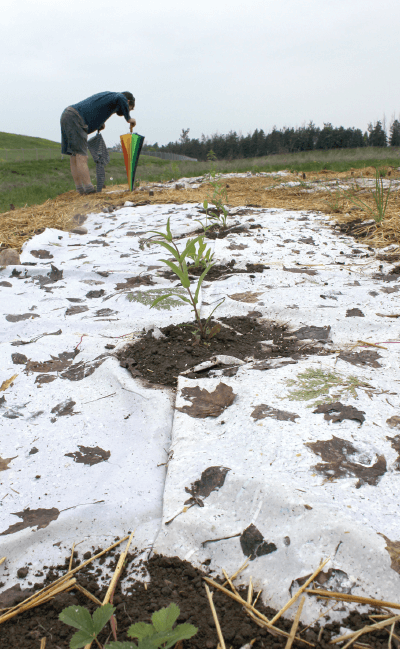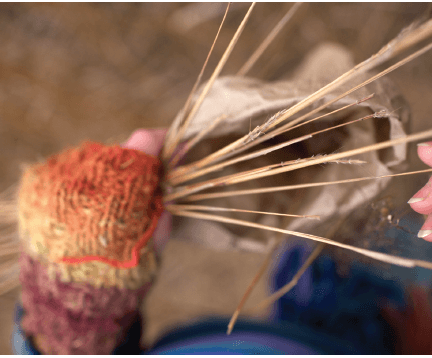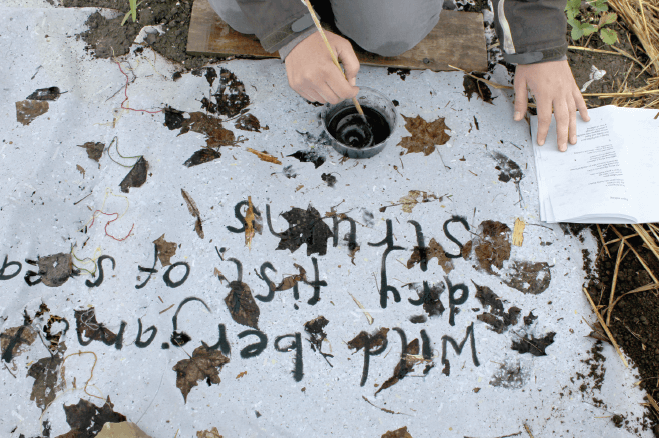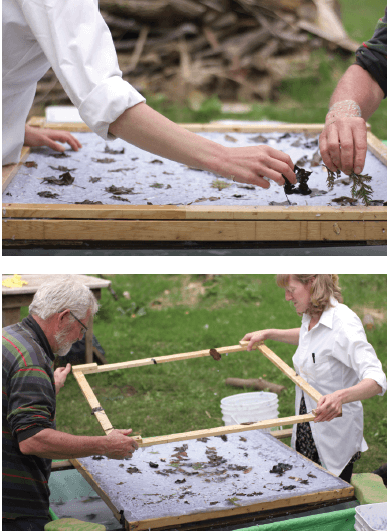The birds, the bees, and the world
Anna Bowen (poetry)
Guelph’s ReMediate project connects devastating bee loss, our food system, and the environment
In spring 2014, the ReMediate project brought together artist Christina Kingsbury, writer Anna Bowen, and non-profit Pollination Guelph, to make a 305 square metre quilt for the decommissioned Eastview Landfill in Guelph, Ont. Embedded with native seeds Kingsbury collected, the quilt was made from recycled paper and plant material. Sewn together entirely on site, the quilt is now in the process of biodegrading, taking root, and becoming a living habitat for threatened pollinators, such as native solitary and ground nesting bees, bumble bees, butterflies, and other indigenous species. Pollinators account for plant reproduction and are responsible for an estimated one out of three bites of food people eat. Devastatingly, however, there is a widespread global decline in pollinator diversity due to habitat loss, pesticide exposure, and climate change.
The Eastview Landfill site was historically wetland, and in parts, farmland. In use from 1961-2003, the site is now capped with clay and harvested for methane. Through research and interviews with professionals and citizens who held memories and information about the site, Bowen and Kingsbury documented fragments of its natural and waste history. The interviews informed Bowen’s accompanying poetry, which tells the story of the layered history of the landfill site, the writer’s experience, and the making of the quilt. During the installation, as Kingsbury sewed, Bowen printed selections from her poetry onto the sewn quilt. The public was invited to hear the poetry at audio listening stations on-site and to participate in the performative process of sewing and planting.
A gesture of care that critiques the exploitation of land and labour inherent in a consumer culture, the ReMediate project makes many connections: between work that is devalued in our economic paradigm; the labour of bees and pollinators; the domestic labour of women; and the low-wage labour of outsourced workers. Its creation embodies an intimacy that moves beyond commodification and nurtures different possibilities for relating with ecology.
Pins and needles
I
The man leans back and shifts his weight
looks out the kitchen window to the barn
He sees the starlings like iron filing overhead
the slump of bulrushes near the swamp
The spring peepers are out
and fireflies will light the field this evening
His son has seen them,
so many splinters of light caught glowing in the grass
He leans back and glances at the clock
its sturdy oak and constant ticking comfort
His wife does the dishes
her hands are ruddy from the scalding and soapless water
II
Women sewing together remember the landfill
how people would gather and compare their trash
Mattresses with the springs poking through
fridge magnets from trips to New York, burnt out night lights
The fabric puckers, a scramble for seam rippers
the plastic kettle is reboiled for decaffeinated tea
—I heard the man who sold the land took his own life
when he found out it was going to be a dump
—I heard that too
III
The man goes out to the barn once his dishes are done
takes the slop to the barrel-bodied pigs
Hey-o there you are
The boys have gone back out to play kick the can
to catch frogs in the failing light by the edge of the marsh,
its fat-thumbed bulrushes bobbing in the low wind
IV
Seams ripped, the women resume their sewing
Pull-pull, sew
Pull-pull, sew
One of the women pours the boiled water for tea
scalds a finger, stomps her foot
Recovered, she produces a wax paper-lined tin from her shopping bag,
passes around butter cookies
—I heard it was the neighbour.
We know the wildness
We know the wildness
that treads above the two foot thick clay cap:
Coyote flank in the cold wood
that traces the edge of the creek
The unlikely heron arcing down to land
on an October hillside between fence and vetch—
somewhere deep in the cells of its iron-feathered wings
its heron body knew this place
An apple tree gone wild but sweet
having thrown off years of pruning
We know that wildness
we feel its paws on the clay cap
breaking into the shell like an egg tooth
slipping through a membrane of soap and
sinking up to its coyote knees in plastics
But the unread wildness awaits us:
decay, the shuddering of elements coming home



